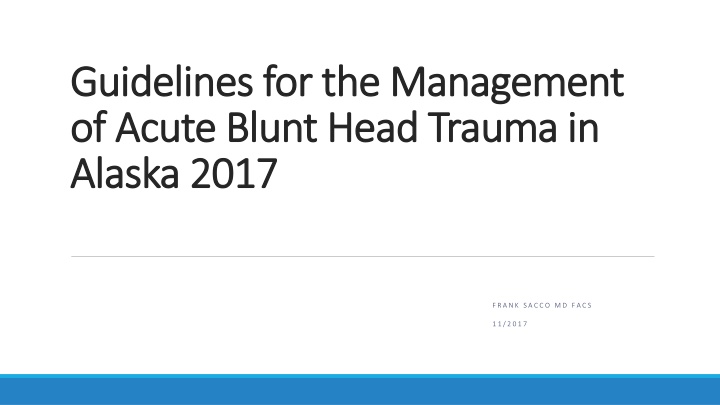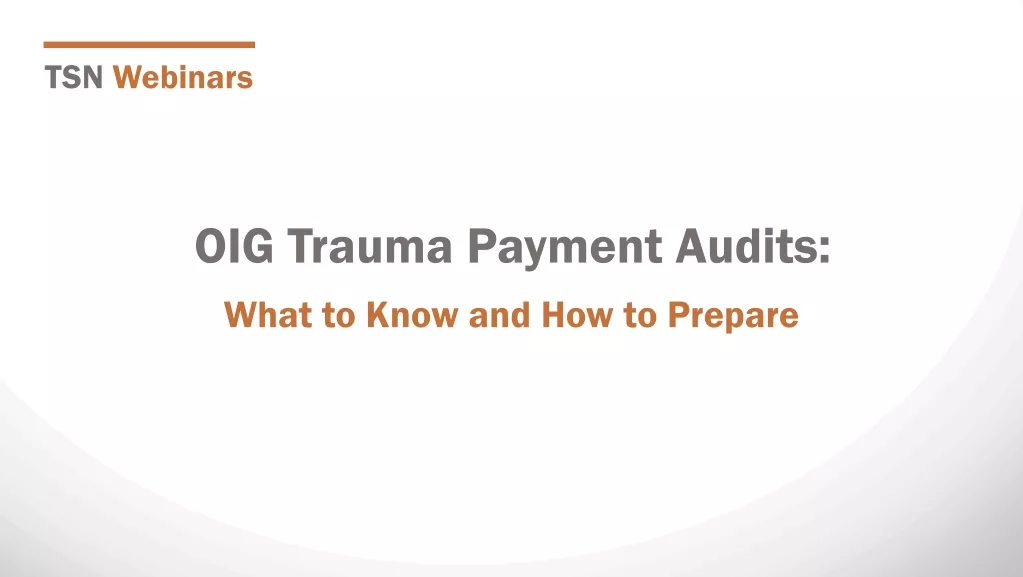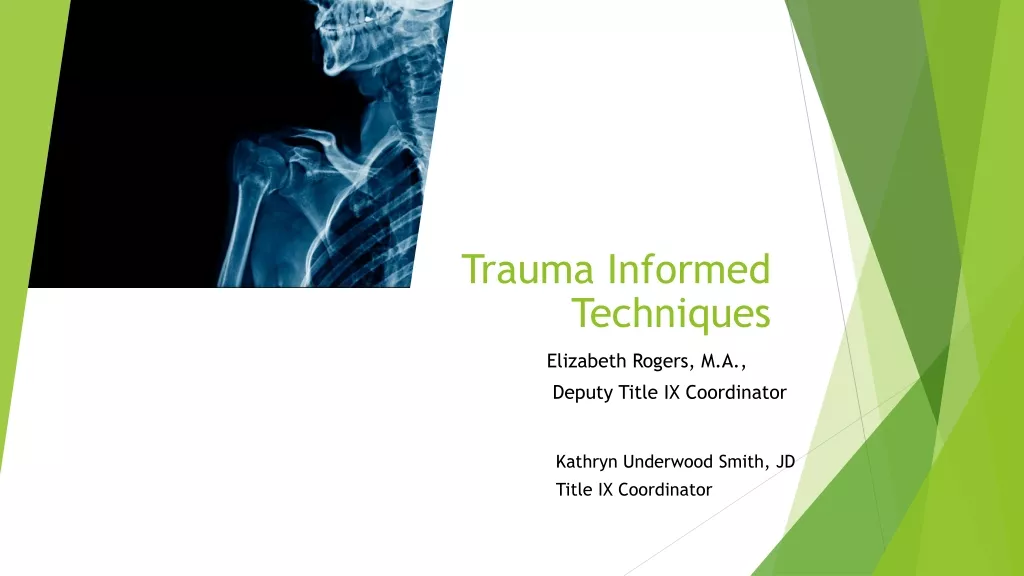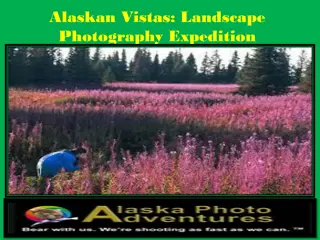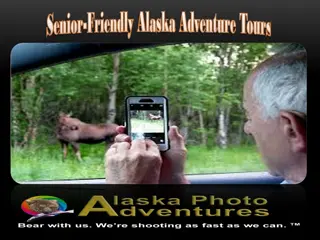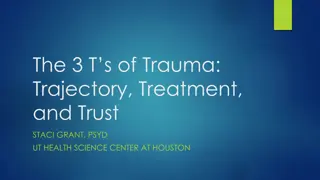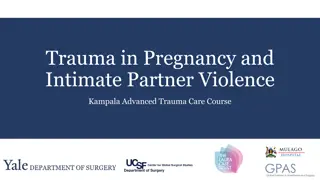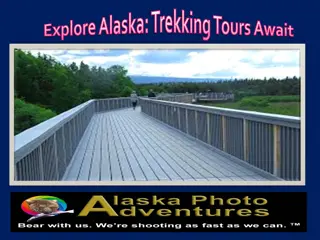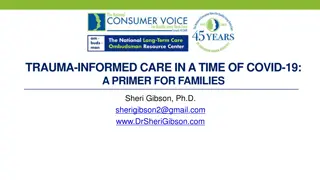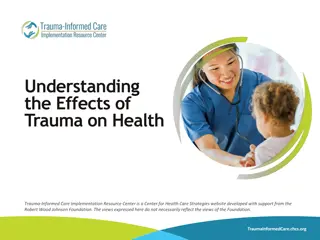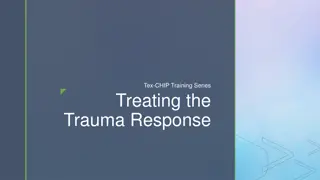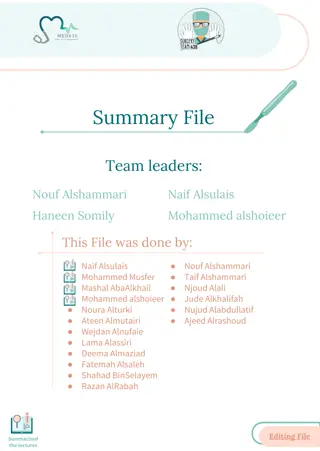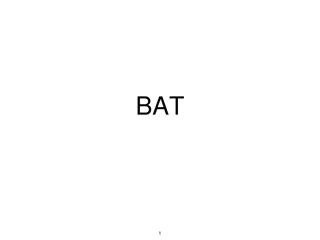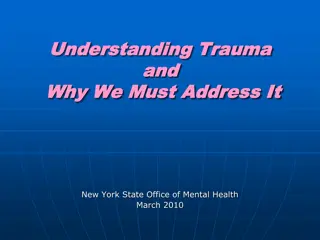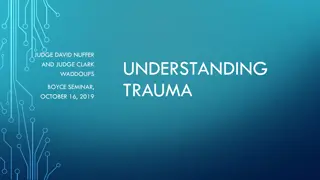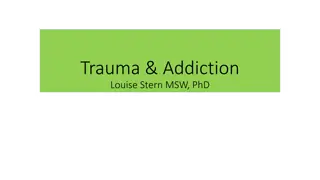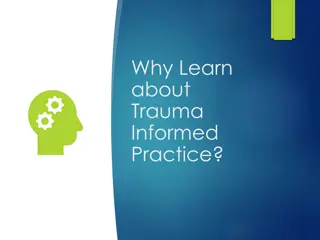Management Guidelines for Acute Blunt Head Trauma in Alaska
Management guidelines for acute blunt head trauma in Alaska include statistics on isolated blunt head injuries, transferred patients from non-neurosurgical facilities, patients kept in non-neurosurgical facilities with GCS 14-15, natural history of minor and moderate head injury, and the use of teleradiology and neurosurgical consults to manage head injured patients effectively, reducing unnecessary transfers. Studies show favorable outcomes with telehealth consultations in neurosurgery triage and consultation.
Download Presentation

Please find below an Image/Link to download the presentation.
The content on the website is provided AS IS for your information and personal use only. It may not be sold, licensed, or shared on other websites without obtaining consent from the author.If you encounter any issues during the download, it is possible that the publisher has removed the file from their server.
You are allowed to download the files provided on this website for personal or commercial use, subject to the condition that they are used lawfully. All files are the property of their respective owners.
The content on the website is provided AS IS for your information and personal use only. It may not be sold, licensed, or shared on other websites without obtaining consent from the author.
E N D
Presentation Transcript
Guidelines for the Management Guidelines for the Management of Acute Blunt Head Trauma in of Acute Blunt Head Trauma in Alaska 2017 Alaska 2017 F R A N K S A CCO M D F A CS 1 1 / 2 0 1 7
Isolated Blunt Head Injury in Alaska Isolated Blunt Head Injury in Alaska 2011 2011- -2015 2015 1873 Isolated blunt head injuries. About half (966) taken care in Anchorage/Seattle , Half (907) at hospital without neurosurgical capability 74.5% (1397) GCS of 14,15 10.2% (191) GCS 9-13 15.2% (285) GCS 3-8 About one patient /day admitted with isolated blunt head trauma. Many more patients when you consider patients seen and discharged from EDs and patients with TBI and multisystem trauma are not included in these numbers
Transferred Patients from Non Transferred Patients from Non- -neurosurgical Facilities Sample 600pts with CT report and entered in state trauma registry neurosurgical Facilities Mild 44% transfer rate Transferred patients CT scans 82% abnormal 18% normal Moderate 66% transfer rate Severe 70% transfer rate
Patients kept in Non Patients kept in Non- -neurosurgical facilities with GCS 14 facilities with GCS 14- -15 neurosurgical 15 (sample 260) 260 patients with GCS 14 or 15 initially admitted non-neurosurgical facilities. 6.5% Secondary transfer rate (Transfer to another facility after initial admission at another hospital) There were no deaths in this group of 260 patients initially admitted to non-neurosurgical facilities.
Natural History of Minor and Moderate Head Injury
Teleradiology and Neurosurgical consults Teleradiology and Neurosurgical consults Head injured patients can be managed using teleradiology with neurosurgeon review. Telehealth consultations reduce patient transfers with subsequent low rates of late transfer due to either clinical or radiological deterioration. Ashkenazi I, Zeina AR, Kessel B, Peleg K, Givon A, Khashan T, Dudkiewicz M, Oren M, Alfici R, Olsha O. Effect of teleradiology upon pattern of transfer of head injured patients from a rural general hospital to a neurosurgical referral centre: follow-up study. Journal of Emergency Medicine. 2015;32(12):946-50. Moya M, Valdez J, Yonas H, Alverson D. The impact of a telehealth web-based solution on neurosurgery triage and consultation. Telemedicine Journal and E-Health. 2010;16:945-949.
Teleradiology for Head Injury Italy Germany Israel All with extensive use and experience with Teleradiology for TBI. All showed 60-70% reduction in need for transfer
Results of UNM Gallup Teleradiology Pilot 42% (11) patients were treated locally 58% (15) patients were transferred to UNMH or elsewhere Treatment Location Local Level I Trauma Center
2003 Alaska Head Injury Guidelines 2003 Alaska Head Injury Guidelines Guidelines developed when many rural facilities did not have CT scan on site. Question in 2003 Which patients with blunt head trauma need to be transferred for Neurosurgical care or CT imaging? Since then many rural facilities have acquired CT scan availability Neurosurgery still only consistently available in Anchorage or Seattle. The additional Question today 2017 is Which patients with blunt head trauma and abnormal head CT scans need to be transferred to a facility with neurosurgical capabilities ?
Medevac Safety and Availability Medevac Safety and Availability (NIOSH) reported that commercial pilots flying on commuter airlines or charters in Alaska have a mortality rate five times that of pilots in the rest of the United States.2 Although the safety of aeromedical evacuation services has improved over time, the risk to patients and flight crews remains an important factor in deciding to transfer patients. Despite increased availability of medevacs it is still a limited resource and if it is activated the region may be uncovered for time critical emergencies .
Medevac Costs Medevac Costs The cost of aeromedical transportation varies greatly across the state. Fixed wing transportation costs to Anchorage ranges from $19,000 from the Mat-Su Valley to $82,000 from Barrow. Transport costs to Seattle, average approximately $160,000 per transport. Aeromedical evacuation costs in the Southeast region are similar to Anchorage or Seattle . These risks and costs must be weighed when considering patient transport.
Medivac Cost by City Transfer to Anchorage vs Seattle $250,000.00 $200,000.00 $150,000.00 Axis Title Cost to Anchorage FIXED WING $100,000.00 Cost to Seattle FIXED WING $50,000.00 $-
2017 Management of Head Injured 2017 Management of Head Injured Patients Patients Since 2003 many rural facilities have acquired CT scan availability. Neurosurgery still only consistently available in Anchorage or Seattle. The dominant Question today 2017 is: Which patients with blunt head trauma and abnormal head CT scans need to be transferred to a facility with neurosurgical capabilities ?
Head Trauma Guideline Task Force Head Trauma Guideline Task Force Frank Sacco M.D. Chair. General Surgery. Anchorage. Trauma Director, Alaska Native Medical Center. William Montano M.D. General Surgery. Fairbanks. Patti Paris M.D. Emergency Medicine. Anchorage. Alaska Native Medical Center. Cody Augdahl M.D. Family Medicine. Nome. Norton Sound Health Corporation. Elisha Brownson M.D. General Surgery. Anchorage. Alaska Native Medical Center. Julie Rabeau R.N. Anchorage. Department of Health and Social Services. Suzanne Fix M.D. Neurosurgery. Anchorage. Coastal Neurology and Neurosurgery. Ambrosia Romig M.P.H. Anchorage. Department of Health and Social Services. Ellen Hodges M.D. Family Medicine. Bethel. Yukon-Kuskokwim Health Corporation. Ben Rosenbaum M.D. Neurosurgery. Anchorage. Anchorage Neurosurgical Associates. Rick Janik R.N. Juneau. Bartlett Regional Hospital. Ryan Urbonas M.D. Neurosurgery. Anchorage. Alaska Native Medical Center. Maria Mandich M.D. Emergency Medicine. Fairbanks. Fairbanks Memorial Hospital. Darrell Mathieu I.D.M.T. Elmendorf Air Force Base. Joel Verbrugge M.D. Radiology. Anchorage. Alaska Native Medical Center. Ryan McGhan M.D. Intensive Care. Anchorage. Providence Alaska Medical Center. Anne Zink M.D. Emergency Medicine. Mat-Su Regional Medical Center.
Methods Methods Ad Hoc committee formed comprised of Neurosurgeons, Trauma surgeons, ED physicians, Hospitalist/Critical Care, Radiology and prehospital representation. Anchorage Fairbanks Nome Bethel Juneau JBER MatSu
Methods Methods The literature on evaluating head injured patients was reviewed by a subgroup of providers. Special attention to guidelines from other organizations and from prospective or high volume retrospective studies. Synopsis of pertinent literature and references for these studies sent out to participants prior to the meeting. Previous guidelines included for review. Meeting convened on February 2017 Guidelines approved and disseminated October 1 2017. Will do interim review Spring 2018.
Limitations Limitations- -Small Children and Infants Small Children and Infants Evaluation of head trauma in infants and small children presents challenges. These guidelines apply to clinical practice for children over the age of five. Issues include: Younger children are at higher risk for reactive cerebral edema. Sedation is required for CT in the very young and carries a small but significant risk. Lifetime radiation risk from CT is theoretically higher. 1 fatal malignancy /1000-10000 scans. Availability of skilled medical personnel with training to monitor the very young patient. (Alaska Guidelines for under 5yo to be developed in 2018)
Limitations Limitations Alcohol and Drug Use. Alcohol and Drug Use. GCS utility is limited as triage tool however presence of risk factors still suggests need for CT in severely impaired patients. If no signs of trauma, but GCS 13 Patients should be monitored by a healthcare provider with hourly neurochecks. If clinical deterioration, head CT scan should be obtained or the patient should be transferred for CT imaging. If there no clinical improvement (return to GCS 15) after six hours, a head CT scan should be obtained or the patient should be transferred for CT imaging.
Limitations Limitations- -other conditions other conditions These guidelines do not apply to strokes or hemorrhage not associated with trauma. - apply for blunt head trauma and are not recommended for penetrating head trauma. - apply to isolated head injury and are not recommended for patients with significant multi-trauma injuries.
Definitions Definitions- -Acute Blunt Head Trauma Acute Blunt Head Trauma Blunt traumatic brain injury (TBI) is a disruption in the normal function of the brain that can be caused by a bump, blow, or jolt to the head. Includes falls that lead to head strike, including ground level. An acute injury is one that is evaluated within 24 hours of the traumatic event.
Definitions Definitions- -Medical observation Medical observation Neuro checks performed by a health care provider, at least hourly for a minimum of six hours. The patient should remain at the facility for a health care provider to perform these checks. Medical observation may be liberalized if the patient returns to GCS 14-15.
Definitions Definitions- -Glasgow Coma Scale Glasgow Coma Scale Eye(s) Opening Best Motor Response Spontaneous 4 Obeys commands 6 To speech 3 Moves to localized pain 5 To pain 2 Flexion withdraws from pain 4 No response Verbal Response 1 Abnormal flexion 3 Oriented to time, place, person 5 Abnormal extension 2 Confused/disoriented 4 No response 1 Inappropriate words 3 Incomprehensible sounds 2 No response 1
Definition Definition- -Patients on Anti Patients on Anti- -coagulant and anti anti- -platelet therapy platelet therapy coagulant and Patients who are on anti-coagulants or anti-platelet therapy pre- injury have been found to be at increased risk of intracranial hemorrhage following blunt head trauma.12-15 Anti-coagulants warfarin direct oral anticoagulants (DOACs). Anti-platelet therapy includes clopidogrel and aspirin. excluding aspirin therapy alone up to 325mg/day.
Risk Factors Risk Factors *** RISK FACTORS ***RISK FACTORS Clinical or radiographic signs of skull fracture Age > 65 Anticoagulation/Coagulopathy Fracture on skull x-ray Focal neurologic deficit Hemotympanum New onset seizures Battle s sign Vomiting > 2 episodes Raccoon eyes Amnesia > 30 minutes CSF leak High energy mechanism
Definitions Definitions- -Abnormal CT findings not requiring neurosurgical Abnormal CT findings not requiring neurosurgical consultation or transfer: consultation or transfer: Several imaging abnormalities have been found to have no clinical significance or risk for deterioration in the setting of isolated blunt head trauma.3,11 Non-depressed skull fracture, open or closed Isolated pneumocephalus Solitary cerebral contusion < 10mm Multiple cerebral contusions < 5mm Subarachnoid hemorrhage < 5mm Subdural hemorrhage < 5 mm These exceptions do not apply to patients who are on anti-coagulant or anti-platelet therapy.
Guidelines for the Management of Acute Blunt Head Trauma in Alaska Guidelines for the Management of Acute Blunt Head Trauma in Alaska GCS 15 No Risk factors *** See Canadian Head CT Rule GCS 14 GCS 9-13 GCS 8 or less without risk factors *** GCS 14-15 with risk factors *** 1.Protect airway 2.Avoid hypoxia 3.Avoid hypotension 4.Elevate HOB if able 5. Cspine immobilization 5. Cspine immobilization 1.Protect airway 2.Avoid hypoxia 3.Avoid hypotension 4.Elevate HOB if able CT Scan of head/ Cspine Medical observation for 2 hours No improvement CT scan of head/cspine if doesn t delay transfer. CT scan of head/cspine if doesn t delay transfer. Send images for review Send images for review NO CT INDICATED Discharge with head injury patient education sheet and competent observer Obtain CT Scan head/Cspine Normal CT findings Abnormal CT or CT not obtained Normal CT findings Abnormal CT findings ** Normal CT findings findings Normal CT NEUROSURGERY TELERADIOLOGY CONSULT Send images for review Transfer or admit locally for observation after neurosurgery consultation 1.Admit locally 2.Medical observation 3.Consider repeat CT if deterioration or no clinical improvement in 23 hrs. 4. GCS drop of 2 is significant 1.Medical observation 2.Discharge with competent observer when GCS 15 . 3. Consider repeat CT if deterioration or no clinical improvement in 23 hrs. 4. GCS drop of 2 is significant TRAUMA CONSULT after images sent for review Transfer or admit to Trauma Center with neurosurgical capabilities **ABNORMAL CT FINDINGS NOT REQUIRING CONSULTATION OR TRANSFER Non depressed skull fracture open or closed Solitary cerebral contusion < 10mm Multiple cerebral contusions < 5mm Subarachnoid hemorrhage < 5mm Isolated pneumocephalus Subdural hematoma< 5 mm DOESN T APPLY TO PATIENTS ON ANTICOAGULATION ***RISK FACTORS Age > 65 Anticoagulation/Coagulopathy Focal neurologic deficit New onset seizures Vomiting > 2 episodes Amnesia > 30 minutes High energy mechanism *** RISK FACTORS Clinical or radiographic signs of skull fracture Fracture on skull xray Hemotypanum Battle s sign Racoon eyes CSF leak
GCS 15 without risk factors Canadian CT Head Rule: GCS 15 No Risk factors *** See Canadian Head CT Rule A non-contrast head CT should be considered in head trauma patients with no LOC or post-traumatic amnesia if there is any of the following factors present: Suspected open or depressed skull fracture Signs of basilar skull fracture (hemotympanum, raccoon eyes, Battle s sign, oto-/rhinorrhea) 2 or more episodes of vomiting Age 65 Failure to reach GCS 15 within 2 hours of injury Retrograde amnesia to the event 30 minutes NO CT INDICATED Discharge with head injury patient education sheet and competent observer Dangerous mechanism of injury (pedestrian struck, ejected from MVC, fall from > 3 feet) **These criteria exclude age < 16, use of blood thinners, or patients with seizure after injury or neurologic deficit.
GCS 14 without risk factors GCS 14 without risk factors GCS 14 without risk factors *** Medical observation for 2 hrs. If GCS improves to 15 NO CT and discharge home with head injury patient education sheet. Medical observation for 2 hours If no improvement CT scan head and cspine Normal CT observe until GCS 15 NO CT INDICATED Discharge with head injury patient education sheet and competent observer Obtain CT Scan head/Cspine Repeat CT if deterioration or no clinical improvement in 23 hrs. GCS drop 2 is significant Abnormal CT findings -Neurosurgical Teleradiology Consult Abnormal CT findings ** Normal CT findings Send images for review. 1.Medical observation 2.Discharge with competent observer when GCS 15 . 3. Consider repeat CT if deterioration or no clinical improvement in 23 hrs. 4. GCS drop of 2 is significant Transfer or admit locally for observation after neurosurgery consult NEUROSURGERY TELERADIOLOGY CONSULT Send images for review Transfer or admit locally for observation after neurosurgery consultation
GCS 9-13 and GCS 14 with risk factors All patients should have a CT scan GCS 9-13 GCS 14-15 with risk factors *** If CT scan is normal Admit locally for medical observation. CT Scan of head/ Cspine Consider repeat CT if deterioration or no clinical improvement in 23 hrs. GCS drop of 2 or more is clinically significant. If CT is abnormal Normal CT findings Abnormal CT findings ** Send images for Neurosurgery Teleradiology Consult Transfer to trauma center or admit locally for observation based on neurosurgery consultation NEUROSURGERY TELERADIOLOGY CONSULT Send images for review Transfer or admit locally for observation after neurosurgery consultation 1.Admit locally 2.Medical observation 3.Consider repeat CT if deterioration or no clinical improvement in 23 hrs. 4. GCS drop of 2 is significant
GCS 8 or less Protect the airway. GCS 8 or less Avoid hypoxia and hypotension 1.Protect airway 2.Avoid hypoxia 3.Avoid hypotension 4.Elevate HOB if able 5. Cspine immobilization 5. Cspine immobilization 1.Protect airway 2.Avoid hypoxia 3.Avoid hypotension 4.Elevate HOB if able Elevate head of bed if possible. Cspine immobilization. CT scan of head/cspine if doesn t delay transfer. Send images for review Send images for review CT scan of head/cspine if doesn t delay transfer. CT scan of head and Cspine if doesn t delay transfer. Send images for review. Abnormal CT or CT not obtained Normal CT findings findings Normal CT Normal CT Consult Trauma Service Abnormal CT - Transfer to Trauma Center with neurosurgical capability Transfer or admit to Trauma Center with neurosurgical capabilities TRAUMA CONSULT after images sent for review
ANTICOAGULATION OR ANTIPLATELET THERAPY (Including ground level falls, excluding patients on aspirin) GCS 14 or 15 who are on anti-coagulants or anti-platelet therapy. a non-contrast CT head should be obtained and consideration of C-spine CT if clinically indicated. Warfarin - INR level <3. If the head CT imaging is normal , medical observation locally for a minimum of 12 hours. After medical observation and GCS to 15 discharge with a competent observer and head injury patient education sheet. The patient should be counseled that they are at increased risk of a delayed bleed and should be given warning signs requiring repeat medical evaluation.
ANTICOAGULATION OR ANTIPLATELET THERAPY (Including ground level falls, excluding patients on aspirin) GCS 14-15 CT imaging normal, INR level is 3 medical observation locally with a repeat head CT in 23 hours or if clinical deterioration. Discontinuation of warfarin therapy and consideration of reversal as clinically appropriate. If repeat CT imaging remains normal, patient may be discharged with a competent observer and head injury patient education sheet. The patient should be counseled that they are at increased risk of a delayed bleed and should be given warning signs requiring repeat medical evaluation.
ANTICOAGULATION OR ANTIPLATELET THERAPY (Including ground level falls, excluding patients on aspirin) CT imaging is abnormal Images via teleradiology for review by a neurosurgeon. Local admission or transfer based on neurosurgical recommendations. Consideration of reversal should be made in consultation with neurosurgery. Patients with GCS 13, the previous guidelines may be followed. Check INR levels if the patient is on warfarin therapy. Consideration of reversal if the INR is 3 or if CT shows intracranial hemorrhage.
REVERSAL ANTICOAGULATION ON ACUTE BLUNT HEAD TRAUMA PATIENTS REVERSAL ANTICOAGULATION ON ACUTE BLUNT HEAD TRAUMA PATIENTS (Including ground level falls, excluding patients on aspirin)
ABNORMAL CT FINDINGS USUALLY NOT ABNORMAL CT FINDINGS USUALLY NOT REQUIRING CONSULTATION OR TRANSFER REQUIRING CONSULTATION OR TRANSFER **ABNORMAL CT FINDINGS NOT REQUIRING CONSULTATION OR TRANSFER Non depressed skull fracture open or closed Solitary cerebral contusion < 10mm Multiple cerebral contusions < 5mm Subarachnoid hemorrhage < 5mm Isolated pneumocephalus Subdural hematoma< 5 mm DOESN T APPLY TO PATIENTS ON ANTICOAGULATION
Emergency Craniotomy Emergency Craniotomy Decision should only be made in consultation with a neurosurgeon. Decompressive craniotomy or burr holes should be a consideration only if: -There is CT imaging consistent with an epidural or subdural hematoma. -The patient is rapidly deteriorating. -A facility with a neurosurgeon is more than two hours away. Most importantly, there needs to be a surgeon capable of doing the procedure along with the necessary equipment.
Non Salvageable Head Injuries Non Salvageable Head Injuries Patients should be medically optimized with: protection of the airway, avoidance of hypoxia, avoidance of hypotension, elevating the head of bed to greater than thirty degrees if possible, and cervical spine immobilization.
Non Salvageable Head Injuries Non Salvageable Head Injuries Patients should undergo CT scan imaging and prompt neurosurgical teleradiology consult. In some circumstances, it is reasonable not to transport these patients to a facility with neurosurgical capabilities. This decision should be made with the input of a neurosurgical consultation. It is appropriate to transport patients with brain death or impending brain death that are potential organ donors.
Conclusions Conclusions An approach to the evaluation of head injured patients in Alaska, including facilities that do not have a neurosurgeon or CT imaging available. It is an attempt to combine a reading of current literature with the realities of medical practice and resource availability in our state. It is not meant to replace clinical judgment. There are limits to the applicability of these guidelines, including small children and infants and patients under the influence of drugs or alcohol.
Conclusions Conclusions Our state is unique in the factors that may play into obtaining CT scans or neurosurgical consults, especially the frequent need for aeromedical transport and delays in care. Our hope is that this will offer some guidance to clinicians faced with caring for the head injured patient in this very challenging environment. In addition, it will help us utilize our transport and subspecialty resources in a safe, responsible, and efficient manner.
